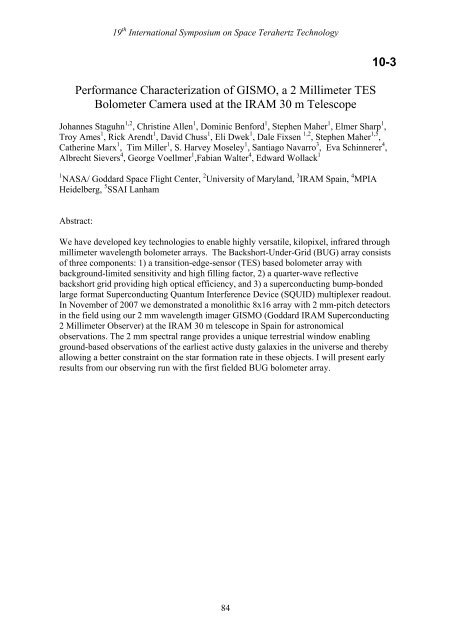Program and Abstract Book - SRON
Program and Abstract Book - SRON
Program and Abstract Book - SRON
Create successful ePaper yourself
Turn your PDF publications into a flip-book with our unique Google optimized e-Paper software.
19 th International Symposium on Space Terahertz Technology<br />
Performance Characterization of GISMO, a 2 Millimeter TES<br />
Bolometer Camera used at the IRAM 30 m Telescope<br />
10-3<br />
Johannes Staguhn 1,2 , Christine Allen 1 , Dominic Benford 1 , Stephen Maher 1 , Elmer Sharp 1 ,<br />
Troy Ames 1 , Rick Arendt 1 , David Chuss 1 , Eli Dwek 1 , Dale Fixsen 1,2 , Stephen Maher 1,5 ,<br />
Catherine Marx 1 , Tim Miller 1 , S. Harvey Moseley 1 , Santiago Navarro 3 , Eva Schinnerer 4 ,<br />
Albrecht Sievers 4 , George Voellmer 1 ,Fabian Walter 4 , Edward Wollack 1<br />
1 NASA/ Goddard Space Flight Center, 2 University of Maryl<strong>and</strong>, 3 IRAM Spain, 4 MPIA<br />
Heidelberg, 5 SSAI Lanham<br />
<strong>Abstract</strong>:<br />
We have developed key technologies to enable highly versatile, kilopixel, infrared through<br />
millimeter wavelength bolometer arrays. The Backshort-Under-Grid (BUG) array consists<br />
of three components: 1) a transition-edge-sensor (TES) based bolometer array with<br />
background-limited sensitivity <strong>and</strong> high filling factor, 2) a quarter-wave reflective<br />
backshort grid providing high optical efficiency, <strong>and</strong> 3) a superconducting bump-bonded<br />
large format Superconducting Quantum Interference Device (SQUID) multiplexer readout.<br />
In November of 2007 we demonstrated a monolithic 8x16 array with 2 mm-pitch detectors<br />
in the field using our 2 mm wavelength imager GISMO (Goddard IRAM Superconducting<br />
2 Millimeter Observer) at the IRAM 30 m telescope in Spain for astronomical<br />
observations. The 2 mm spectral range provides a unique terrestrial window enabling<br />
ground-based observations of the earliest active dusty galaxies in the universe <strong>and</strong> thereby<br />
allowing a better constraint on the star formation rate in these objects. I will present early<br />
results from our observing run with the first fielded BUG bolometer array.<br />
84
















